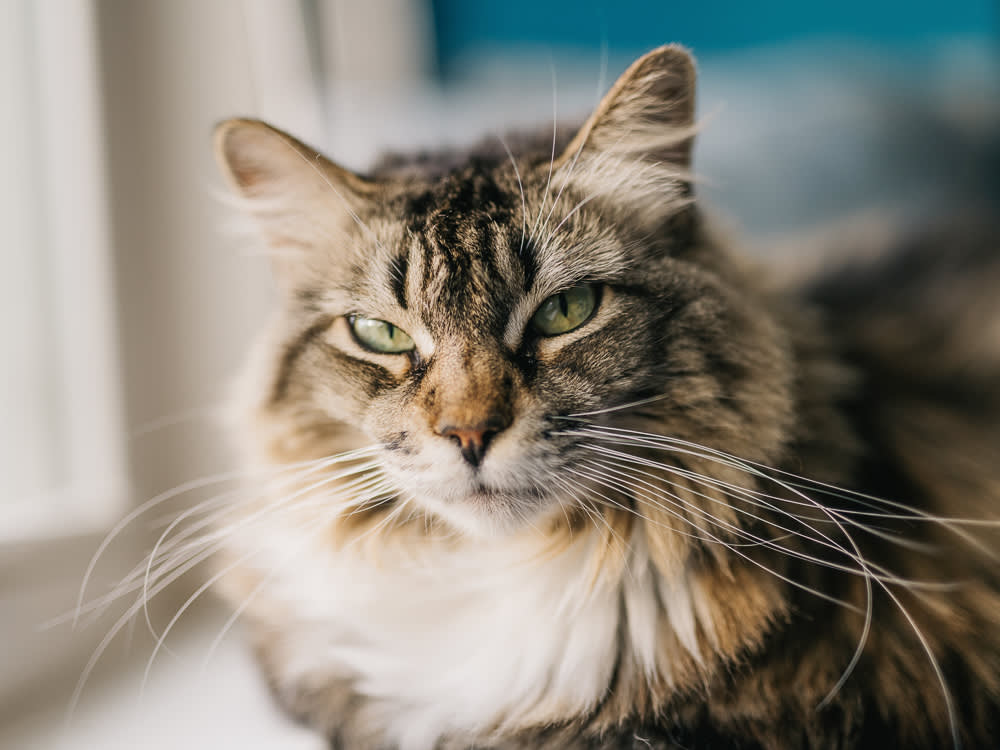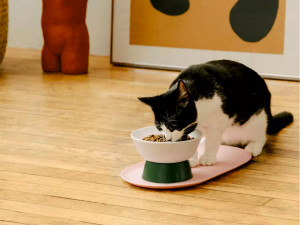Whisker Fatigue — Apparently It’s a Thing
Or, is it a genius marketing ploy to get you to buy fancy “whisker friendly” cat bowls? We asked a vet...

share article
Cats are mysterious creatures, so it’s no wonder they have a wacky syndrome all their own. Whisker fatigue, also known as whisker stress, is a newly described phenomenon that refers to the overstimulation a cat experiences when their whiskers brush up against the sides of a narrow or deep bowl. Basically, it’s the feline equivalent of the sensory overload you may experience in loud, crowded, chaotic environment. Turns out this unpleasant sensation can cause stress and discomfort, which can lead to cats not drinking water or eating, stop eating and drinking entirely, or paw at their food and water, spilling it onto the floor.
Is whisker fatigue really a thing?
To be clear, veterinary professionals don’t all agree that whisker fatigue is real — some think it’s a clever marketing ploy to sell “whisker friendly” cat bowls that are wider and shallower than traditional pet bowls. A recent studyopens in a new tab found no support for the theory of whisker stress, though some of the study cats did seem to prefer the whisker-friendly dishes — go figure. This is not to say that whisker fatigue or whisker stress does not exist. A cat’s whiskers are extremely sensitive. These thick, hollow structures are deeply embedded into nerve-filled follicles under the skin.
“From an anatomic and physiologic perspective, it’s entirely possible for overstimulation of a cat’s whiskers to cause problems,” says Dr. Gary Weitzman, DVM, CEO of the San Diego Humane Society, and author of the National Geographic Complete Guide to Pet Health, Behavior, and Happiness: The Veterinarian's Approach to At-Home Animal Care (2019). “Each time a cat’s whiskers encounter an object or detect movement, a signal is sent to the brain. In the case of too many signals or messages coming in all at once, the brain could experience information overload which could be stressful for a cat.”
How do I tell if my cat has whisker fatigue?
One of the primary signs of whisker fatigue is a cat exhibiting signs of stress, hesitation, and agitation around feeding times. If your cat displays any of the following behaviors, it’s possible that whisker fatigue is to blame:
· Avoiding the food bowl
· Pacing in front of the food bowl
· Vocalizing while at the food bowl
· Pawing at the food bowl
· Fishing food out of the bowl to eat off the floor
· Not finishing the food
It’s important to schedule a visit with your veterinarian any time a cat stops eatingopens in a new tab or drinking since it can be a sign of a serious medical issue. Lots of illnesses and injuries can cause a cat to stop eating or drinking, so always have your cat checked out instead of assuming it’s a behavioral issue. If your cat gets a clean bill of health from the vet, the food bowl avoidance could be due to whisker fatigue.
What do I do if my cat has whisker fatigue?
The good news is that the solution for whisker fatigue is simple: Replace your cat’s narrow, deep food and water bowls with something flat or wide and shallow so your cat’s whiskers don’t touch the sides of the dish. Although you can buy special “whisker friendly” cat bowls, you can also try a flat dinner plate from your own collection or even a disposable paper plate. “Cats also love lip-less, flowing water sources,” says Dr. Weitzman. “There are automatic cat water fountains for purchase that are really fantastic.”
Finally, try to avoid touching your cat’s sensitive whiskers. “It may be tempting when you are petting a cat, but it’s best not to touch them,” Dr. Weitzman adds. “And whatever you do, never trim your cat’s whiskers. Cats need them for their expressions, perceptions, orientation, safety, and general well-being.”

Jackie Brown
Jackie Brown lives in sunny Orange County, CA, where she works as a freelance writer and editor. When she’s not on deadline, you can find her paddling her outrigger canoe in the Pacific Ocean or hiking in the foothills with her miniature poodle and two young boys.

